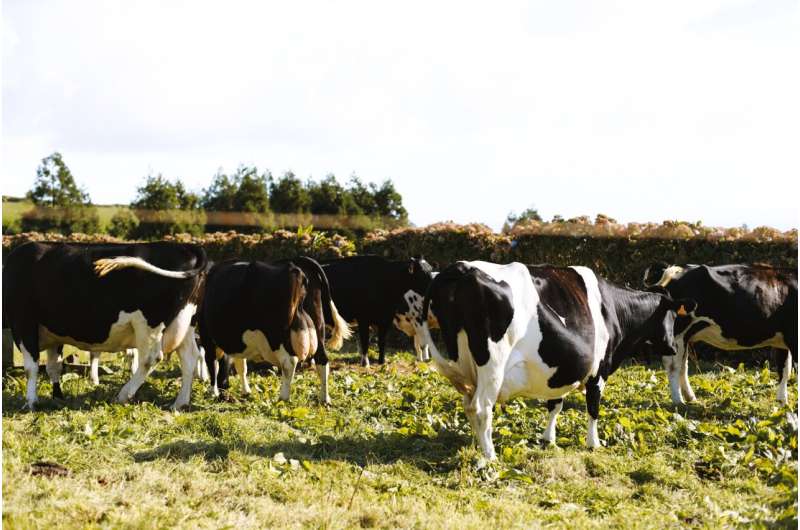This article has been reviewed according to Science X's editorial process and policies. Editors have highlighted the following attributes while ensuring the content's credibility:
fact-checked
trusted source
proofread
Study identifies biting flies as reservoirs of bacteria that cause bovine mastitis on dairy farms

Bovine mastitis, which affects cows, leads to reduced milk production and can be fatal if left untreated. The USDA National Animal Health Monitoring System has reported cases in 99.7% of all dairy operations in the U.S., making it the most prevalent disease on dairy farms.
Pathogenic bacteria and other microbes cause the condition, though the exact mechanisms of transmission—especially by flies, which are known to potentially play a role in many dairy farm diseases—haven't been clearly elucidated.
A study published in mSphere has identified Stomoxys flies (also known as stable flies) as carriers of pathogenic bacteria that cause bovine mastitis.
Researchers at the University of Wisconsin-Madison sequenced microbial communities from these biting flies at two connected dairy farms, then compared those findings to manure samples from the same farms. In both samples they identified bacterial taxa associated with bovine mastitis.
Notably, the researchers found that the pathogenic microbes, which included colonies of Escherichia, Klebsiella and Staphylococcus bacteria, were fairly rare and scattered in the manure samples. In the fly samples, however, those same species showed dramatically higher abundance. That mismatch strongly suggests that the pathogenic bacteria readily colonize and persist in the fly gut.
"The flies are bona fide reservoirs of these bacteria," said microbiologist and senior author Kerri Coon, Ph.D., whose lab focuses on disease vectors and insect-microbe interactions.
"Their gut is not only permissive to colonization by clinically relevant groups of bacteria, but these bacteria are able to grow and multiply to become dominant members of the fly microbiome." The stable flies, she said, may actually be helping to maintain these pathogens in the environment.
Previous studies have linked stable flies to bovine mastitis, Coon notes, but most have focused on mechanical transmission by looking at pathogens that can stick to a fly's body or legs and be transmitted when a fly lands on an open sore or opening in the cow's body.
The new work, she said, points to insect bites as an additional route of transmission. When a stable fly bites a cow, it injects salivary proteins that help it access and digest blood. That process, Coon said, offers an opportunity for the pathogens to pass from the fly's microbiome to the cow's body.
Using high-throughput 16s rRNA sequencing, Andrew Sommer and Julia Kettner, both graduate students in Coon's lab, analyzed internal samples from a total of 697 flies and compared those to data from 106 manure samples, all collected from two dairy farms in southern Wisconsin.
The manure samples showed a significantly higher diversity of bacterial species than the fly samples, but taxa associated with mastitis were found in much higher abundances in the matched fly samples.
"We know manure acts as a reservoir of pathogens, but they're pretty patchy, and environmental or opportunistic pathogens are generally at low abundance," Coon said. "So when a cow gets an opportunistic or environmental kind of bovine mastitis infection, we want to know how it got there."
In previous work, Coon investigated the role of insect-microbiome interactions in mosquitoes. She launched the new study with support from the University of Wisconsin Dairy Innovation Hub, which brings together dairy farmers and researchers to support the state's dairy industry.
In addition to implicating the microbiome of biting flies as a reservoir for pathogens, Coon said the new work may help guide better strategies for protecting cows from bovine mastitis—and even for protecting people from possible zoonotic infections.
"I think there's a lot of excitement about tapping these insect microbiomes as a resource" for preventive or protective strategies on dairy farms, she said. "But first we have to understand the fundamental processes underlying how these insects and microbes behave, and potentially contribute to disease transmission, in the field."
More information: mSphere (2024). journals.asm.org/doi/10.1128/msystems.00336-24
Provided by American Society for Microbiology





















